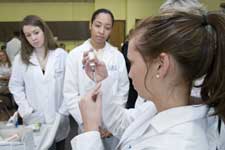
A patient with diabetes seeks an alternative to insulin injections.
KINGSTON, R.I. – May 4, 2007 -So a new inhaler that provides a painless alternative is the answer, right?
It isn’t if the patient has severe arthritis and trouble with dexterity. It might not be an alternative for a patient with memory or concentration issues either because it is a complex device with many preparation steps.
That was just one topic as University of Rhode Island nursing and pharmacy students joined for the first time to share their knowledge and different perspectives on caring for patients with diabetes. This spring, 100 fifth-year pharmacy students and 75 junior nursing students participated in the cross-disciplinary program.
At four separate stations, they learned about different methods for checking blood-sugar levels and insulin delivery methods such as traditional insulin injections, insulin pens, and insulin powder inhalers. Nursing students gave pharmacy students injections of saline to simulate insulin shots while pharmacy students and faculty led small group sessions on different medication delivery and monitoring systems.
Celia MacDonnell of Newport, clinical assistant professor of pharmacy, and Mary Lavin of Middletown, clinical assistant professor of nursing, said the students gained awareness of the benefits of teamwork.
“We tell our students in our respective colleges to work as a team with other health care professionals, but we haven’t been able to foster that in an interactive setting that brings together students from each discipline,” MacDonnell said. “We have been trying to do this for years, but it has been very difficult because of the off-campus clinical demands on both groups of students. But we can’t expect people to be a team if they have never worked together as students.”
Lavin found in her informal conversations with students that they were pleased with the exercise. “The nursing students found the student pharmacists to be very knowledgeable about the medication, the drugs’ effects and their side effects,” Lavin said. “The nursing students were also excited about sharing their knowledge about glucose monitoring and insulin injection techniques, especially the information that pharmacists could use to educate patients.”
Lavin and MacDonnell plan to offer the diabetes program again next year, and they hope to use a similar approach to address a second health care issue, medication management.
Stacey Cugno, a nursing major from Berlin, Conn. had just finished a session that demonstrated the use of the insulin powder inhaler. “I can’t see my 82-year-old grandmother doing this,” Cugno said referring to the complexity of the device.
Nursing student Marcia Pryce of Boston said the program was good for nurses because pharmacists can assist them with the various delivery and testing devices. “But we can help them because we see the outcomes and challenges of various treatment options,” Price said.
“I liked this program because it helped us understand what the patient goes through,” said pharmacy student Shannon Stahler of Woodcliff Lake, N.J.
Laura Daley, a pharmacy student from Coventry, said she gained a new appreciation for the skill of nurses in administering injections. “They are very smooth and coordinated. This gives us all a much better understanding of what each group does.”
“We are going to work together no matter what the setting,” Stahler said. “It benefits the patients if we don’t have conflicts.”
Heather Anderson, a nursing student from Richmond whose mother is a graduate of the pharmacy college, said her mother was excited about the program. “My mom thought it was good to integrate both groups because they have different points of view.”
“This (cooperation among different professions) is the new face of health care,” said pharmacy student James Medeiros of Charlestown. “Clinicians today tend to be diverse, younger and they are more accustomed to sharing information.”
Media Contact: Dave Lavallee, 401-874-5862

